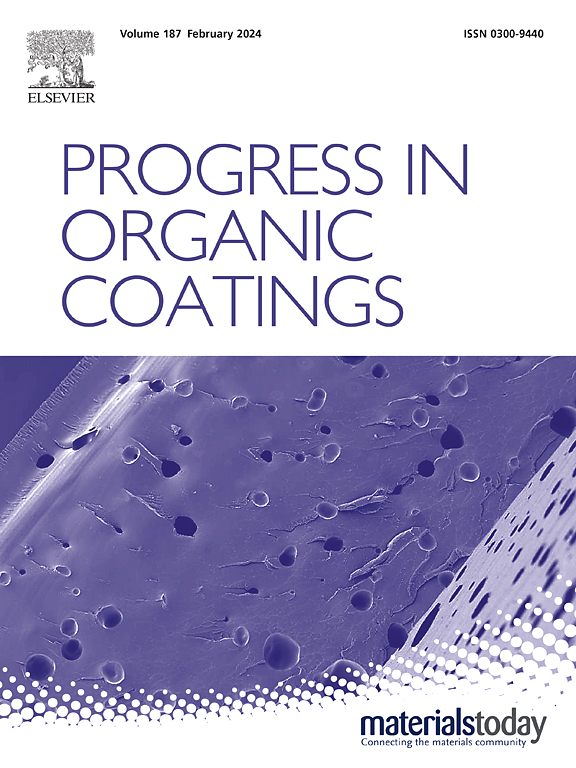Dynamically omniphobic and highly transparent polyurethane coating towards efficient self-cleaning on photovoltaic modules
IF 6.5
2区 材料科学
Q1 CHEMISTRY, APPLIED
引用次数: 0
Abstract
Photovoltaic (PV) modules have become a powerful contributor to global CO2 emissions mitigation, but have suffered a significant loss in power generation efficiency caused by the deposition of surface contamination. Conventional self-cleaning coatings typically require laborious fabrication processes, elaborate texturing, and fluorinated materials, which are difficult to integrate with transparency, environmental compatibility, and adaptability. Herein, we show a highly transparent, fluorine-free, and dynamically omniphobic liquid-like polyurethane coating (LLPuC) prepared by well cross-linking between polydimethylsiloxane (PDMS)-grafted hydroxyacrylate (PxHAy) copolymer and polyisocyanate at elevated or room temperature. The LLPuC could be applied to various substrates by spraying or blading methods and has demonstrated good transparency (91.79 % at 550 nm) of the coated glass. The liquid-like flexible chains of PDMS were enriched on the LLPuC and moved spontaneously, resulting in a smooth surface with dynamic omniphobicity (WSA = 11.5 ± 0.6°, OSA ≤ 15°), anti-smudge, and self-cleaning capability, as evidenced by the LLPuC coated PV module achieving a 92.83 % efficiency recovery ratio after the self-cleaning process. Moreover, the obtained coating also exhibited good adhesion strength, flexibility, anti-abrasion, and stability. Thus, the approaches and findings in this work have opened up a new avenue for self-cleaning coatings of PV modules and various outdoor transparent devices.
动态全疏和高透明聚氨酯涂层,用于光伏组件的高效自清洁
光伏(PV)组件已成为全球二氧化碳减排的有力贡献者,但由于表面污染的沉积,发电效率遭受了重大损失。传统的自清洁涂层通常需要费力的制造工艺、精细的纹理和含氟材料,这些材料很难与透明度、环境兼容性和适应性相结合。在此,我们展示了一种高透明、无氟、动态全疏的液体状聚氨酯涂层(LLPuC),该涂层是由聚二甲基硅氧烷(PDMS)接枝羟基丙烯酸酯(PxHAy)共聚物和多异氰酸酯在高温或室温下良好交联制备的。LLPuC可以通过喷涂或喷涂方法应用于各种基材,并显示出良好的涂层玻璃透明度(在550 nm处为91.79%)。液体状的PDMS柔性链在LLPuC上富集并自发移动,形成光滑的表面,具有动态全疏性(WSA = 11.5±0.6°,OSA≤15°)、抗污性和自清洁能力,经自清洁处理后LLPuC涂层光伏组件的效率回收率达到92.83%。此外,所得涂层还具有良好的附着力、柔韧性、抗磨性和稳定性。因此,本工作的方法和发现为光伏组件和各种户外透明器件的自清洁涂层开辟了新的途径。
本文章由计算机程序翻译,如有差异,请以英文原文为准。
求助全文
约1分钟内获得全文
求助全文
来源期刊

Progress in Organic Coatings
工程技术-材料科学:膜
CiteScore
11.40
自引率
15.20%
发文量
577
审稿时长
48 days
期刊介绍:
The aim of this international journal is to analyse and publicise the progress and current state of knowledge in the field of organic coatings and related materials. The Editors and the Editorial Board members will solicit both review and research papers from academic and industrial scientists who are actively engaged in research and development or, in the case of review papers, have extensive experience in the subject to be reviewed. Unsolicited manuscripts will be accepted if they meet the journal''s requirements. The journal publishes papers dealing with such subjects as:
• Chemical, physical and technological properties of organic coatings and related materials
• Problems and methods of preparation, manufacture and application of these materials
• Performance, testing and analysis.
 求助内容:
求助内容: 应助结果提醒方式:
应助结果提醒方式:


